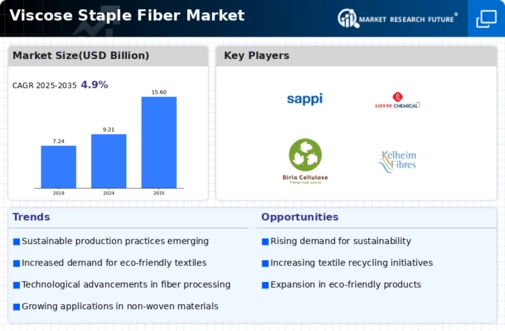Market Diversification
The Global Viscose Staple Fiber Market Industry is experiencing diversification in its applications, which is contributing to its growth. Beyond traditional uses in textiles, viscose staple fiber is increasingly being utilized in non-woven applications such as hygiene products, medical textiles, and industrial fabrics. This expansion into new markets is likely to drive demand and increase the overall market size. As industries seek versatile materials that offer both performance and sustainability, viscose staple fiber is well-positioned to meet these needs. The ongoing diversification of applications may further solidify its role in the global market, enhancing its appeal across various sectors.
Textile Industry Growth
The Global Viscose Staple Fiber Market Industry is significantly influenced by the expansion of the textile sector, which continues to thrive globally. As fashion trends evolve, the demand for versatile and high-quality fabrics has surged, with viscose staple fiber being a preferred choice due to its softness and drape. The textile industry is projected to grow at a steady pace, contributing to the anticipated market value of 15.6 USD Billion by 2035. This growth is likely driven by the increasing production of apparel and home textiles, where viscose staple fiber plays a crucial role in enhancing product quality and consumer satisfaction.
Sustainable Fiber Demand
The Global Viscose Staple Fiber Market Industry is witnessing a pronounced shift towards sustainability, driven by increasing consumer awareness regarding environmental issues. As brands and manufacturers prioritize eco-friendly materials, the demand for viscose staple fiber, which is derived from renewable resources, is expected to rise. This trend is evidenced by the growing adoption of viscose in various applications, including textiles and non-woven products. The market is projected to reach 9.21 USD Billion in 2024, reflecting a robust interest in sustainable alternatives. Companies are increasingly investing in sustainable production processes, which may further enhance the appeal of viscose staple fiber in the global market.
Technological Advancements
Technological innovations in the production of viscose staple fiber are reshaping the Global Viscose Staple Fiber Market Industry. New manufacturing techniques and processes are being developed to enhance fiber quality while reducing environmental impact. For instance, advancements in closed-loop production systems are minimizing waste and energy consumption, which could lead to a more sustainable supply chain. These innovations not only improve the efficiency of viscose production but also align with the growing demand for eco-friendly products. As a result, the market is likely to experience a compound annual growth rate of 4.93% from 2025 to 2035, reflecting the positive impact of these technological developments.
Rising Consumer Preferences
Consumer preferences are evolving, with a marked increase in the demand for natural and biodegradable fibers. The Global Viscose Staple Fiber Market Industry is benefiting from this trend, as viscose is perceived as a more sustainable alternative to synthetic fibers. This shift is particularly evident among environmentally conscious consumers who prioritize products made from renewable resources. Retailers and manufacturers are responding by incorporating viscose into their product lines, which is likely to enhance market growth. The increasing popularity of viscose in various applications, including clothing and home textiles, suggests a promising future for the industry, as it aligns with consumer values and preferences.















Leave a Comment